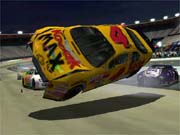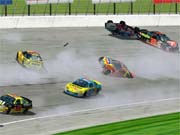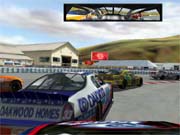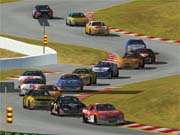It was 14 years ago that Dave Kaemmer founded Papyrus Design Group and began development of what is generally regarded as the first realistic racing game for the PC, Indianapolis 500: The Simulation. Since then, Papyrus has almost single-handedly defined what an automobile racing simulation should be. Its latest project, NASCAR Racing 4, is the glorious culmination of years of experience and expertise. Though it has occasional quirks, it is far superior to recent installments and makes for an unquestionably outstanding racing experience for NASCAR fans.

NASCAR Racing 4 distinguishes itself from competing products in the same way Papyrus' simulations always have--through a faithful attention to realism. But NASCAR Racing 4 is far from just another upgrade. The game features a new and vastly improved vehicle physics model that makes the once impressive but now antiquated NASCAR Racing 2 and 3 cars seem like they were riding on rails. It benefits from a new graphics engine that renders everything prior obsolete. In fact, everything about NASCAR Racing 4 is state of the art, from the improved menu interfaces with pop-up tooltips to the enhanced computer-driver artificial intelligence, the top-quality audio, and much more.
Like earlier iterations, NASCAR Racing 4 showcases the world of top-level stock car racing, the Winston Cup series. It incorporates no fewer than 76 real-life drivers and cars, including such luminaries as Jeff Gordon, Bobby Labonte, Mark Martin, and even the feared black #3 Goodwrench GM of Dale Earnhardt, whose untimely death followed the release of the game. It features last year's complete 21-track roster, including the Indianapolis Motor Speedway and the storied Daytona and Pocono circuits, which make their first-ever appearance in a Papyrus title. And in a real move forward for the venerable series, NASCAR Racing 4 offers all four body styles from the upcoming 2001 season--now you may choose from the Chevrolet Monte Carlo, Pontiac Grand Prix, Ford Taurus, or the new kid on the block, Dodge's sleek Intrepid R/T. Each is modeled accurately from bumper to bumper.
For players new to the series, the latest NASCAR is less imposing than ever before. Rookies need merely select a car and head to the options menu to activate the game's massive allotment of driving aids. If any of the menu items seems confusing, a quick click of the right mouse button triggers a pop-up explanation. Choose a comparatively relaxed circuit such as Michigan, define the driving mode as "arcade," and keep the opponent strength to the default minimum of 70 percent.
Then it's off to the track, where you'll want to settle on a suitable viewing perspective before continuing. NASCAR Racing 4 offers a total of four points of view, including a superb new hood camera that eliminates the clutter of the cockpit interior while offering the subtle control of a true first-person view. This may well become the perspective of choice for most players. At any time, you can press the F key to check the frame rate or the V key to warp into an opponent's cockpit and watch the work of a seasoned pro. You may even want to access a midrace replay to fully understand why your driving line keeps propelling you into the wall. Unfortunately, Papyrus has inexplicably eliminated NASCAR Racing's instant restart feature, thereby forcing you to live with serious accidents or reload the entire event from the menu--a frustratingly lengthy process on any computer. Fortunately, such miscues are more than offset by the game's impressive list of graphical and practical upgrades.

When series veterans get behind the wheel, the first thing they'll notice isn't the revolutionary physics model, but the great new graphics engine. Papyrus has banished the boxy-looking cars of previous versions and replaced them with stunning true-3D models that move about as a collection of parts rather than as an inflexible mass. Now NASCAR Racing vehicles sport an active four-way suspension that visibly tilts the car when weight transfers from side to side. They feature source-sensitive lighting, awesome real-time shadows, and wheels and tires that look and behave like separate components.
In the event of a serious accident, NASCAR Racing 4 merges tried-and-true Papyrus damage modeling with new vertical physics to create an unforgettable show. Cars are ripped from the ground if propelled with sufficient force, authentically tumbling end-over-end or climbing safety fences before they finally return to the pavement. Hoods buckle, fenders and bumpers crush, and hunks of bodywork break off and violently fly about as they would in a real collision.
But even though the game handles its new airborne element exceptionally well--cars stay aloft only as long as real-world gravity would dictate--the carnage still isn't quite as convincing as it could be. Detached parts seemingly lose their mass once they've departed, thus letting oncoming vehicles drive right through them as if they weren't even there. The flames you'd expect to see erupt never materialize. And the game occasionally clips 3D objects through one another, merging cars with cars and cars with walls instead of catapulting them away from one another. It is not impossible to see a vehicle poke completely through a retaining wall or dip into the pavement as if that pavement were liquid, then suddenly reappear several yards away. Fortunately, such incidents seem limited only to severe collisions, which typically occur only if you go out of your way to create them.
Outside the car, Papyrus has created a gritty environment that looks reasonable outside the normal lines of vision but fantastic where it needs to be. The driving surface in particular is exemplary, as it varies in color and texture from corner to corner and is pockmarked with patches and repairs. Dirt and assorted debris bounce about appropriately, oily grooves form along the racing line, and translucent smoke lingers for minutes after a burst motor or collision.

Of course, everything mentioned above looks much better on a powerful computer. Papyrus really aimed high with NASCAR Racing 4 and enabled 32-bit color and resolutions as high as the fastest video cards will support. With a 1GHz Athlon and a GeForce 2 GTS running at 1024x768 resolution, full-field NASCAR Racing 4 oval races purred along smoothly. Road courses such as Watkins Glen seem a bit more demanding, but the game rarely slows enough to affect performance. Even if your computer isn't up to snuff, the graphics are still quite acceptable at a resolution of 640x480.
Unfortunately, the retail version of the game seems somewhat prone to lockups and crashes. On two test machines, NASCAR Racing 4 locked up an average of once every couple of hours. Granted, fatal errors occurred only when loading a track or switching out of the program--never in the midst of an event.
Nevertheless, NASCAR Racing veterans should be thrilled with what is arguably the game's most important element, the physical on-track experience. NASCAR Racing 4 is noticeably more difficult than NASCAR Racing 3, but at the same time, it's more interesting and not so taxing that you'll get frustrated. In fact, it's a virtually perfect blend of driving realism and difficulty. According to NASCAR Racing 4 senior engineer Shawn Nash, the physics engine used in the game is similar to that of Papyrus' award-winning simulation, Grand Prix Legends. The developers did tweak certain features after making precise measurements based on actual specs gleaned from NASCAR garages.
Most notably, the NASCAR Racing 4 vehicle model feels less attached to the racing surface than the models of its predecessors. It rides upon the track on four distinct and unique points, each of which is quite capable of individual reactions. You will spend more time sliding now. You will spend more time adjusting for turns and correcting during them, especially if you're a habitual late braker. And you will definitely spend more time trying to reel in your rear end, which slowly pitches out when cornering speed is excessive. It is an exceptionally rigorous and exhilarating experience.
On ovals, fast setups clearly pull to the left. On superspeedways, even minor bodywork damage will upset aerodynamics and diminish top speed, giving your artificially intelligent opposition just the break it needs. The NASCAR Racing series has continually offered strong computer opponents, and that much hasn't changed in the latest version. Only now, they are an overtly aggressive bunch. They'll counterattack when you've outbraked them into a turn, and you'll frequently be bumped and even sent into a spin if you don't play it conservatively and give them the room they feel they deserve. They'll chase you down the straight and tap you from the rear if you do something foolish--or even if you don't. Though it's undeniably annoying, such behavior certainly is in keeping with real-life NASCAR action.

In a true testament to their newfound humanity, computer drivers will no longer come to a dead stop when blocked by a stalled or crashed car. Now, they'll move around obstacles intelligently and quickly, thus solving one of NASCAR Racing's more enduring problems. They do remain robotic during pace laps and the first few moments of a race, where their perfect side-by-side alignment seems a bit too predetermined. However, they'll pull all sorts of realistic maneuvers after that, including riding the apron to make a pass or initiating altercations with one another. The result is more independent accidents, which is a welcome change.
Yet even the smartest artificial intelligence doesn't compare to the best human drivers. NASCAR Racing 4 includes sophisticated multiplayer support that permits competition with more than 40 fellow enthusiasts on one of several online services. Performance does seem to vary according to the number of players involved (and, in turn, the time of day), but the thrill of racing real people is worth the hassle. Your best bet is to play over a fast connection and during off-hours.
You'd also be well advised to run the game through a surround-sound audio setup, if only to fully immerse yourself in the diversity of its authentic sound effects. Past versions don't even come close to what Papyrus has prepared this time, particularly during collisions, when the sudden brutality of such an event is effectively translated through an incredible array of gritty crunches and wallops. Even at speed, the intermittent chirps of a blown gear, the scratch of a gentle brush with the wall, the distinctive engine notes, and the assorted undercarriage pings and knocks all add much to the experience.
The game is unfortunately bereft of a career mode, but it does sport the usual single race, testing sessions, championship, and custom season options. The garage is as complex as ever, the paint shop utility is even more refined, and the animated pit crew is atmospheric if still somewhat crude. In final analysis, NASCAR Racing 4 is an enthusiastic and ambitious project that is worthy of any oval lover's attention. Minor blemishes aside, it is easily the finest stock car sim available and quite possibly the best racing game to date.